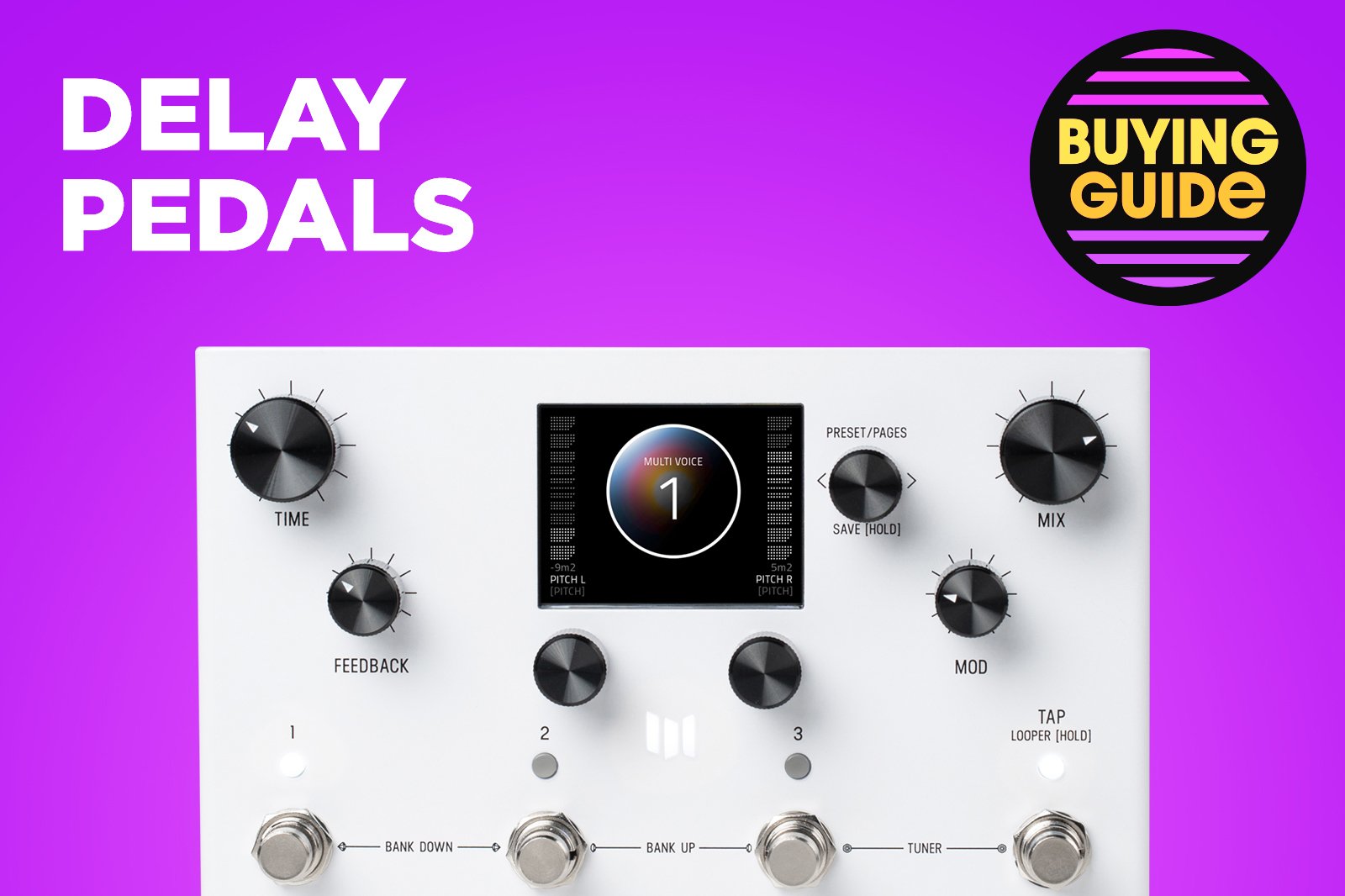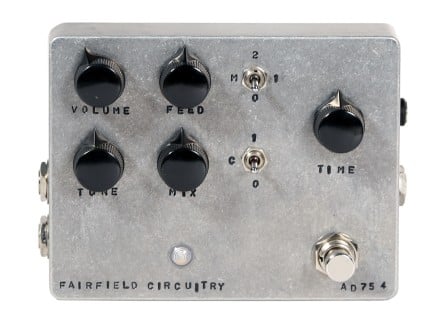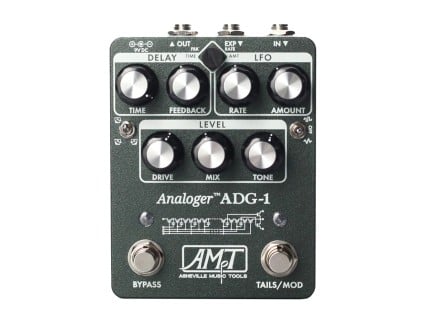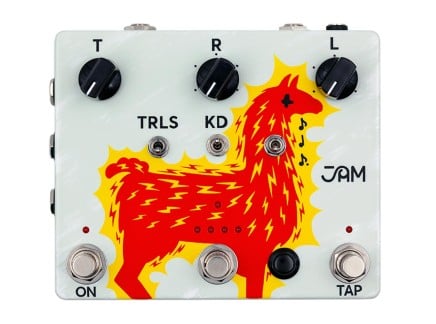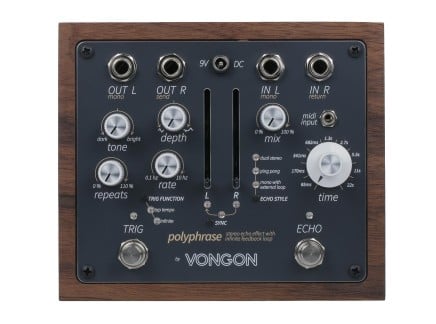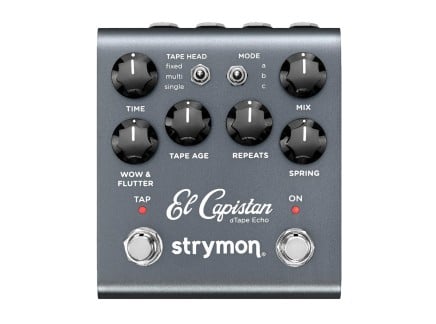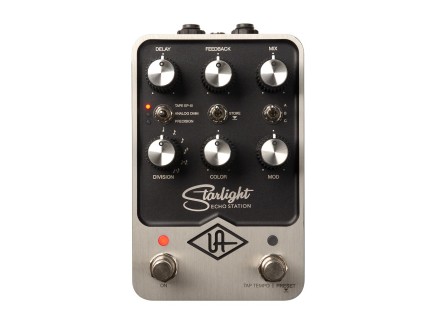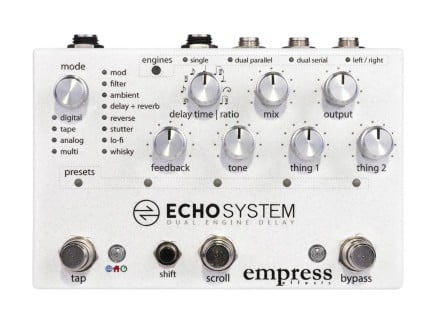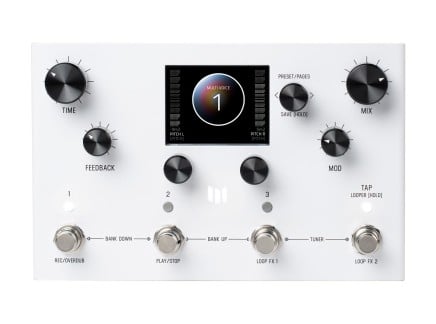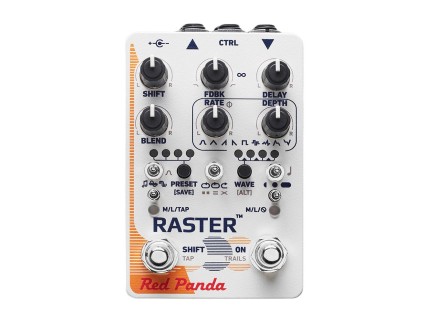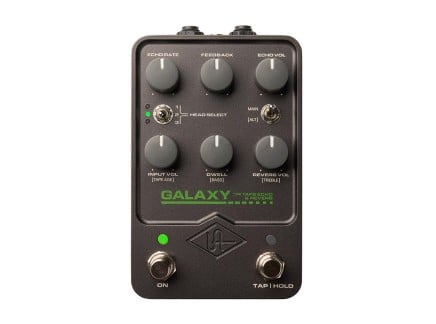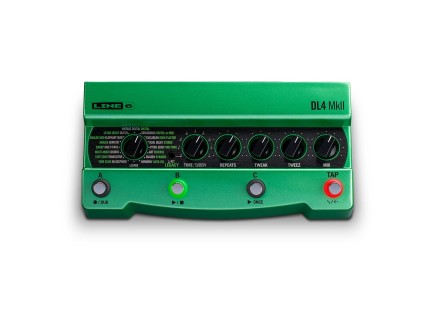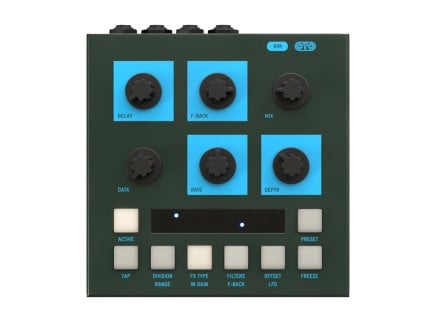Are you building an all-purpose pedalboard for gigging in multiple bands? You need a delay pedal. Are you creating a synth composition and looking to add character and texture? You need a delay pedal. Are you a fan of finding cool gear and noodling with it in your apartment while you marvel at all the aural grandeur summoned by a few knob turns? You definitely need a delay pedal.
Delay is one of the oldest and best-loved effects in the arsenals of musicians and producers alike. Originating in ad hoc reel-to-reel loops which recorded onto tape and fed that copied sound back into an amp, the original tape delays of the ‘50s, '60s, and onward created an echo that can still be heard in music today. As a teenager in the Aughts, I was floored by the playing of Dave Knudsen and his Line 6 DL4 Delay Modeler, a shiny green tank that replicated, spliced, and looped his guitar work into disjointed-yet-infectious lines that are still as clear in my mind as a repeat from an MXR Carbon Copy.
Delay pedals aren’t just useful and ubiquitous: they’re also incredibly fun. They can create lush atmospheres, howling voids of feedback, sparkling accents, entirely new rhythmic phrasing and more with a strum or a key press. Some “purists” say that delay or other effects are somehow cheating your way to creativity, but these people are 1) wrong and 2) boring. When understood as a tool which can aid in creating a sound or can unlock a new realm of sound, delay is like a friendly little elf ready to mimic and play with your playing.
With that said, there are many, many delay pedals currently available on the market, but fear not: all delays fall in one of a few categories, and when you understand these categories in relation to the sound you’re after, you’ll be ready to pick the perfect pedal for hours of sonic experimentation. In this article, we break down some of our favorite delays in these categories: All-Star Analog, Digital Bread & Butter, Digital Delay Workstations, and some additional Weirdo Favorites. Let's dive in!
All-Star Analog Delay Pedals
Warm, organic, and full of character, analog delays have been favored for decades by players who like filling out their sound without much muss or fuss. Technically, tape delay was the first instance of the effect used in a controlled musical application, but we’ll touch on tape later in the guide. For our purposes, analog delays are the old-school entry in this list, but that doesn’t mean they don’t have buckets of fun to offer.
Building on the bad pun you just read, analog delays typically operate on bucket brigade circuitry. Named for the old firefighting technique in which people passed buckets of water in a line, analog delays pass your signal through a series of capacitors. The signal grows weaker and more warped the further it goes, resulting in that signature dark, moody tone that has kept players coming for decades.
Fairfield Circuitry Meet Maude
Speaking of dark delays, the Fairfield Circuitry Meet Maude is a capstone example of what makes analog delay so delicious. Known for their faithful-yet-creative renditions of classic effects with added functionality and built-like-a-tank construction, Fairfield has attracted a loyal following with pedals like the Meet Maude, Shallow Water Lo-Fi Pedal, and Randy’s Revenge Ring Mod.
The Meet Maude is an intuitive but deceptively simple pedal with straightforward controls for Volume, Time (length of the delay), Feed (repeats), Tone, and Mix. Maude also sports two switches: one to control compression for more even repeats, and another for random modulation to create a tape effect.
Remember when I mentioned tape delay? Back in the ‘50s, recording artists figured out that by repurposing a reel-to-reel machine to record their signal directly onto magnetic tape and play it back through an amp, they could achieve a dreamy, cavernous tone that slowly but beautifully degraded over time. Because lugging around technology from half a century ago is pretty inconvenient to most people, the wonderful minds behind many effect companies have created tape delay emulations that would make Les Paul weep.
Back to Maude: the random modulation switch recreates the natural spurts of acceleration and deceleration in tape playback that occurs with repeated use. The result is a perfectly imperfect unfurling of your playing in umbrous waves of decayed glory.
Asheville Music Tools ADG-1
Do you know those famous chefs who personally go to the market for only the finest ingredients and spend hours perfecting them on a plate? Asheville Music Tools founder Rick “Hawker” Shaich is like that, except instead of lamb shanks he deals in circuit boards and transistors. Famously, he was responsible for much of the magic of the Moog Moogerfooger series of effects—and if you're familiar with the famous MF-104, you might notice some similarities with our next suggestion, the Asheville Music Tools ADG-1.
The ADG-1 is the impressive result of that obsession with sound. Built with over 400(!) hand-selected components, the ADG-1 is an audiophile’s dream for some of the purest, richest delay you can get on your board or in your setup. Chief among those 400 components is a pair of Xvive MN3005 Reissue Bucket Brigade Devices (BBDs) which act as the beating analog heart of this pedal.
Quick history lesson: the MN3005 is a chip of legend that helped define the sound of analog delay. Used in countless pedals but most notably in the OG runs of the Electro-Harmonix Memory Man and Boss DM-2 Delay, the MN3005 has attracted a cult following thanks to the chip’s inherently rich character. The Xvive reissues robustly live up to the reputation of their predecessors and deliver that same cavernous warmth in a ridiculously well-built package.
Before the signal hits those BBDs in the ADG-1 (pedal people are an acronym-heavy people), it gets nice and toasty in an onboard preamp before getting sent on its all-analog signal path. The result is up to 700 milliseconds of delay you could soak in for hours, but if some more tinkering suits your fancy, Shaich and company also included an onboard LFO with variable forms for pitch modulation in the delays. Long story short? It's one of the best-sounding analog delays currently available, with a remarkable warmth and an astonishing level of control.
JAM Pedals Delay Llama XTREME
For those of use who can’t help but wonder what something will sound like if the knob goes to 11, the JAM Pedals Delay Llama XTREME is…well, extreme. Reaching for the functionality of weirdo do-it-all delays while keeping its hooves planted in analog territory, the Delay Llama XTREME doles out plenty of experimentation potential that can also just sound like a really awesome analog delay.
The Delay Llama XTREME is built around four presets: Vibrato, Tape, Random, and Pitch-Shift. The list seems short, but each mode offers carefully-selected, tweakable options in an intuitive layout with situational knobs that change function according to their mode. This means more time actually playing and no time lost in the wilderness of menu diving.
The Vibrato mode activates a sine-wave LFO with fine-tuned control over the vibrato’s depth and speed. The Tape mode kicks in a (you guessed it) tape emulation with a big dark sound and control over “frequency of deviation occurrences”, better known as flutter. The third mode, Random, randomly changes the repeat length in set time divisions for some really fun pitch and rhythm madness. The last mode, Pitch-Shift, is actually five different instances of pitch-shifting and playback patterns, the last of which deals you a super fun five-mode sequencer for even more lovely rhythmic and harmonic weirdness.
But wait: the presets are only half of it. The Delay Llama XTREME also packs in a crazy amount of functionality for an analog pedal. This includes onboard Tap Tempo with three time divisions, a Hold (freeze) function, a Kill-Dry switch to quickly dip your signal to full wet (effect all the way up), and Trails (echoes that keep going without a dry signal). Top it off with individual CV inputs for each mode and you’re ready to ride this beast into a world of delay magic.
If the XTREME is too much for your taste, don't fret—JAM Pedals also makes the Delay Llama Mk3, which offers a simpler, more stripped-back set of controls for straightforward, no-nonsense, excellent analog tone (complete with tap tempo control!).
Digital Bread & Butter
Standing in stark contrast to the organic character of their analog cousins, digital delays are bright, uniform copies marching in perfect order out of your amp. Similar to an analog path but a bit more involved, a digital delay first converts the signal from analog to digital, sends it through a digital signal processor (DSP) chip or chips, and then records the sample onto a buffer for later use.
The big takeaway point: analog echoes degrade, but a digital echo is essentially an exact reproduction of your input. That being said, digital delays tend to sound a bit “lighter” or more “hollow” than an analog delay, but this aspect can be seen more as a matter of taste than an issue of quality.
While some digital rack units were in production through the late ‘70s and early ‘80s, the 1983 release of the Boss DD-2 marked digital delay’s entry into and domination of the pedal world. In the ensuing 40 years, the breakneck evolution of technology and the number of amazing minds involved in design and production have resulted in digital delays that can achieve similar fidelity to analog along with functionality that’s simply not possible with their predecessors.
Vongon Polyphrase
First up in the digital delays is a boutique recreation of a studio effect adored by the likes of Prince, Kevin Parker, and Brian Eno. The Lexicon Prime Time was essentially a dual-input rack unit with two separate taps (delays) that could be synced or unsynced with sky-high delay times and an internal modulation VCO for unpredictably warped results.
The Vongon Polyphrase takes the core concept of a stereo dual delay and outfits it with useful modulation options in a spiffy wooden enclosure. What’s really cool about this pedal is how you set and control your delay time: the Time knob to the right designates the max delay time in set increments up to a full 22 seconds, and the nifty sliders at the center control the individual delays and provide fractions of the max delay time from 1 (the set max delay) down to 0.05x. The delays can be synced, but the Polyphrase shines in all its stilted glory when different delay intervals are in play to create the polyrhythmic results that made the Prime Time such a cult figure.
Additionally, the Polyphrase two I/Os for true stereo, a modulation section with waveforms from Sine to Random, a Trigger switch with modes for either tap tempo or infinite feedback, and three modes: Dual Stereo, Ping Pong, and Mono w/ External Loop. This last one turns the right delay into an effects loop for the texture fiends out there. If you’re after beautiful, chimey soundscapes with room to experiment, the Polyphrase is a top candidate.
Strymon El Capistan
Oh Capistan my Capistan: I remember every guitarist I knew pining for one of these sleek boxes like a pair of Nancy Spumoni Snow Boots, and for good reason: this was one of the first pedals that really nailed the warm character of tape delay in a convenient, digital package. Although this is a digital pedal, you should note that the El Capistan is built to sound like a tape delay, so if you also want those sparkly repeats found in the likes of a Boss DD-7, this might not be the best choice for you.
However, if you want easy-peasy tape delay, this is absolutely one of the best choices for you. The El Capistan gives you no-nonsense controls for Time, Repeats, and Mix as well as Tape Age, which emulates the natural decay of real tape, and Wow & Flutter, which emulates that acceleration/deceleration in actual tape playback we mentioned earlier. The Tape Head switch gives you a Fixed mode for a single fixed delay at a variable speed, a Multi mode for two fixed delays at variable speeds with separate time divisions, and a Single mode, which gives you a set speed and variable delay that results in lurching, time-bent wonder. The Single mode is also capable of sound on sound, which loops the recorded echo while you’re playing for lush, evolving soundscapes.
I should also mention that the El Capistan has a nifty secondary function that allows you to dab in some spring reverb, so this unassuming tank is really a twofer.
Universal Audio Starlight
Strymon isn’t the only high-fidelity effects game in town. Universal Audio, renowned for their interfaces and plugins used in top studios around the world, decided in recent years to break out of their virtual box and start producing effect pedals built on their coveted UAD algorithms. Built around a dual-processor design with the UAFX engine doing the heavy lifting, the Starlight Echo Station serves up three delay favorites for even the most discerning effect connoisseurs.
The first, the Tape EP-III, serves up ‘60s-style tape echoes with options for different preamp and tape age settings. The second, the Analog DMM, takes inspiration from the early-era Boss BBD delays. The third, Precision, is a bit of a curveball: you’d expect to see another vintage analog emulation, but this mode is all about digital delay with long times and powerful modulation. Between these three modes, the Starlight Echo Station is a solid candidate for those after a do-it-all delay.
One last but important note: Universal Audio lets you download new effect algorithms directly into the pedal via USB-C, so you can essentially create a new pedal if/when you get bored.
Digital Delay Workstations
The above section gives you a good idea of what to expect in a digital delay, but in 2023, pedal designers have had a lot of time to think about how to juice their pedals and pack in plenty more functionality. Digital Delay Workstations are effects compounds unto themselves that can easily become the focal point of your rig.
There are advantages and disadvantages to this: if you want to spend hours exploring sounds, great! If you’re focused on finishing tracks and don’t want to spend too much time thinking about your board, the workstations probably aren’t your best bet.
Let’s get workstationing!
Empress Echosystem
Clear your schedule: the Echosystem is here.
A sonic command station built around a dual engine system, the Echosystem boasts a dizzying 36 delay and reverb algorithms along with 12 editable parameters for each of those algorithms. You could literally play a single note on your guitar or synth and spend the rest of the day transforming it into an opus.
The list of effects runs the gamut from Analog and Tape to more exotic options like Ambience, Lo-Fi, and Reverse. There’s even a “Whisky” setting that takes two pitched delays and switches between the two when your input signal exceeds a specified threshold.
The Echosystem serves up just as much functionality to go along with all those algorithms. You have the option to route the dual engine in series, parallel, or L/R, implement global and local tap tempos with a buffet of subdivisions, and even a Cab Simulator for good measure. Praise be the Empress Echosystem.
Meris LVX
Perhaps technically more of a multi-effects pedal (or an artifact of future alien technology), the Meris LVX is a beautiful exercise in stunning excess. The term “Modular” is in the name for good reason: this gleaming white box grants minute control of not only five powerful delay structures and three delay types, but command over the levels and ordering dynamics, preamp, filter, pitch, and modulation as you see fit.
This is the type of pedal that you could get lost in and emerge from your bedroom months later with a long beard and thousand-yard stare after seeing the enormity of the cosmos contained in the LVX. It’s such a powerful machine—so powerful that we wrote a dedicated article all about it. For our purposes here, though, if you want absolutely everything in a delay and the best sound possible, there are few that can rival what Meris did here.
Honorable Mention: If you’re a fan of how good the LVX sounds but don’t want/need everything it offers, check out the Meris Hedra Rhythmic Pitch Shifter or Polymoon Stereo Multi-Tap Delay.
Weirdo Favorites
I personally do not take “weirdo” as an insult: misfits make the world fun and keep everyone else guessing as to what’s coming next. The entries in this list blur the lines between delay, reverb, chorus, and other effects with unconventional controls that can yield a sound you’ve never heard with a few knob twists.
Eventide Ultratap
Eventide’s Ultratap is an ultra-powerful multitap delay with features and design that could only come from a company with years of experience making studio-grade products. A quick note: when we say “multitap”, we mean that there are multiple delay signals generated by a single input signal. Think of it like playing into a splitter that sends your signal into different delay pedals that all have their own time and repeat setting.
Fun, right? Now imagine up to 64 delay pedals all crammed into a single pedal and you’ve got a pretty good idea of what the Ultratap brings to the table. You get an impressive amount of control and sonic possibilities with only six knobs, allowing alterations from smearing, slurring, spreading, filtering, and stereo panning. The downside is that each knob is dual-function and switching between two parameters on the same knob can be confusing, but once you get the hang of it, a wealth of delay swells, filter sweeps, glitched-out reverbs and even chorus are on tap for you.
Red Panda Raster 2
Rounding out our buying guide is a powerful little time wizard that wants to take you on an odyssey through harmony and space, the Red Panda Raster 2.
At its core, the Raster 2 is a digital delay with up to 1.6 seconds of delay time, but that barely scratches the surface of what this pedal can do. Five switches on the Raster 2 transform it from an unassuming digital delay into its final evolved Charizard form with chromatic or microtonal pitch-shifting up or down, control over the feedback in forward or reverse, and manipulate feedback division. Add in a hefty modulation section with seven waveforms and an available envelope and the Raster 2 can summon swells, glitches, and waves of lush delay, reverb, chorus, flange, and spatial effects spanning the full stereo spectrum.
Of course, Raster 2 is a quite deep effect—and to better understand its inner workings, be sure to check out our articles Weird FX: Pitch Shifted Delays and Weird FX: Frequency Shifters!

